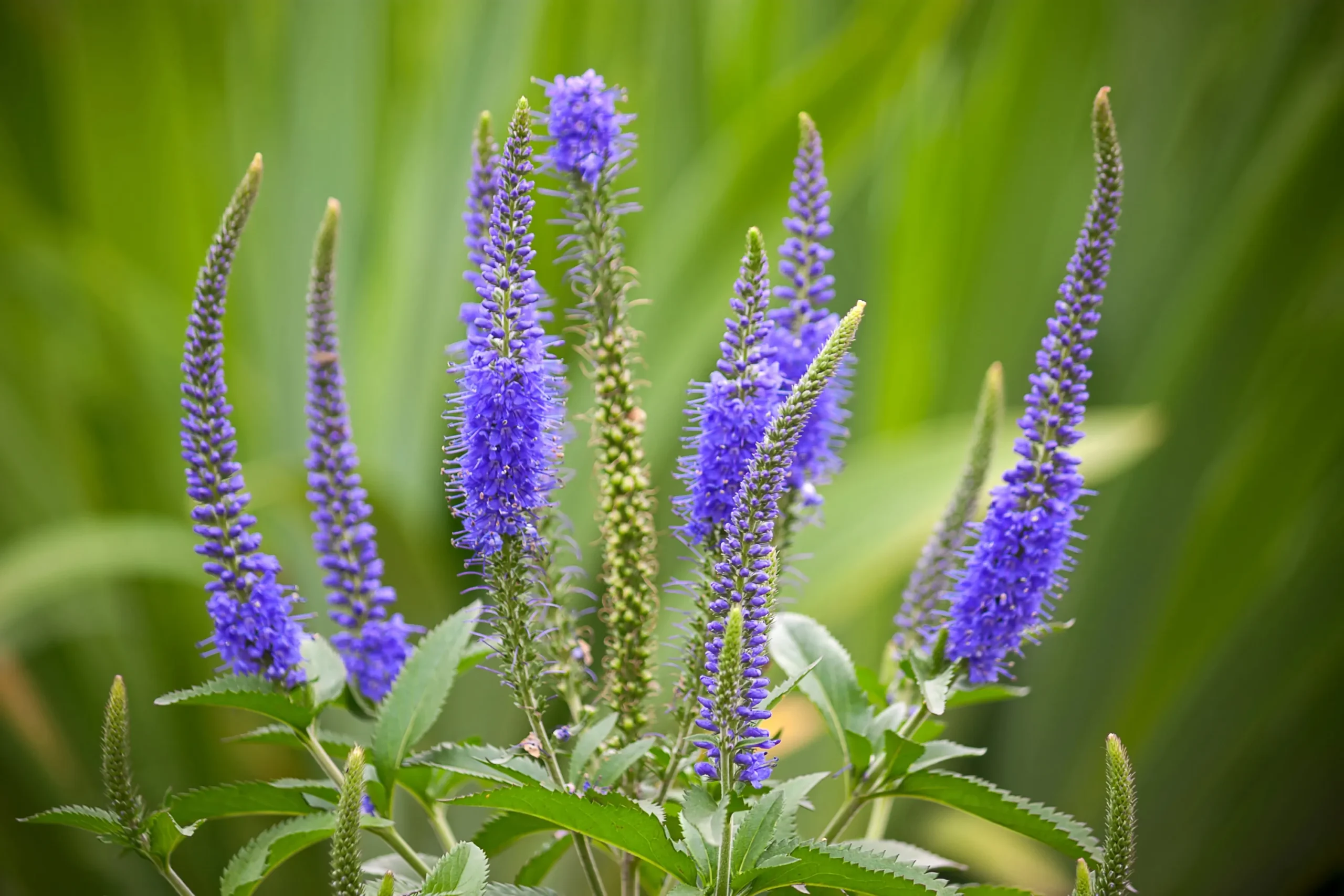Family: Speedwell
Type: Perennial

Veronica spicata, commonly known as Spike Speedwell, is a perennial favorite for its tall, slender spikes of flowers. This plant is a standout in any garden, thanks to its vibrant blooms and elegant, upright form. It’s known for its versatility and ease of care, making it a go-to choice for both novice and experienced gardeners.
Typically reaching heights of 1 to 2 feet, Veronica spicata is perfect for adding height and texture to garden beds. Its flower spikes come in various shades, including blue, pink, and white, offering plenty of options for color coordination in your garden. The plant’s long blooming period, from early to late summer, ensures a vibrant display for months.
Veronica spicata thrives in full sun to partial shade and prefers well-drained soil. It’s relatively drought-tolerant once established, and its resistance to pests and diseases adds to its appeal. Regular deadheading can encourage more blooms and extend the flowering season even further.
Hardiness Zone: 3a-4a
Deer Resistant: Yes
Pet Friendly: Yes
Moisture Preference: Dry to average
Sun Needs: Full sun to partial shade
Drought Tolerance (Xeriscape): Yes
Growth Rate: Medium
Average Height (feet): 3
Average Spread (feet): 1
Average Life Span (years): 8
Form: Over mound
Flower Color: Pink
Secondary Flower Color: Purple
Bloom Season: From early to late summer
Foliage Color: Green
Foliage Shape: Narrow
Veronica spicata is ideal for creating vertical accents in flower beds and borders. Its tall flower spikes add a sense of height and structure, making it a great choice for background plantings. Plant it in groups for a dramatic effect or intersperse it with other perennials for a more dynamic display.
This plant is also perfect for cottage-style gardens. Its natural, airy look complements the informal style of these gardens, and its range of colors can easily be blended into a variety of garden palettes. Plus, its attractiveness to butterflies and bees adds another layer of charm and activity to your garden.
For those with limited space, Veronica spicata is also a great option for container gardening. Its upright growth habit makes it a stunning focal point in pots and planters, either alone or mixed with other flowering plants.

In an English garden, Veronica spicata adds a touch of classic elegance. Its spiky blooms contrast beautifully with the softer forms of traditional English garden plants.
In a meadow-style garden, its naturalistic look blends seamlessly with other meadow plants, creating a relaxed and inviting space.
For modern gardens, Veronica spicata offers a splash of color and texture. Its linear form complements the clean lines of contemporary garden design.
Place Veronica spicata where its height and beauty can be fully appreciated. It’s a great choice for adding depth and interest to your garden throughout the growing season.
Select our pre-made garden layouts to create a landscape that’s uniquely yours. Simple, smart, and customizable!
In spring, Veronica spicata starts to grow, setting the stage for the burst of color that will follow in the summer months.
During summer, the plant is in full bloom, showcasing its striking flower spikes that add vibrancy and height to your garden.
In fall, the flowers of Veronica spicata may fade, but its foliage continues to add texture and interest to the garden.
In winter, while Veronica spicata is dormant, its structure can still provide interest, especially in gardens with snow, where it adds a unique silhouette against the white backdrop.
Veronica spicata thrives in sunny areas but can tolerate partial shade. It’s great for borders, wildflower gardens, or as a part of a perennial bed.
Full sun is ideal for this plant. It encourages robust growth and maximizes flowering, but it can also grow in partial shade.
Well-drained soil is a must. Veronica spicata adapts to various soil types but prefers a slightly acidic to neutral pH.
Space plants about 12-18 inches apart. This allows room for growth and ensures good air circulation around each plant.
Plant Veronica spicata in the spring after the threat of frost has passed. This gives the plant time to establish before the heat of summer.
Dig a hole twice as wide and as deep as the root ball. Place the plant in, fill with soil, and water well. Mulching helps retain moisture.
Water regularly during the first growing season. Once established, Veronica spicata is quite drought-tolerant.
Apply a balanced fertilizer in early spring. Too much fertilizer can lead to more foliage and fewer flowers.
Deadheading encourages more blooms. Cut back in late fall or early spring to promote healthy new growth.
As growth resumes, prune old foliage, start watering, and apply fertilizer to encourage vigorous growth.
Keep an eye on moisture levels during hot weather and deadhead spent blooms to encourage more flowering.
Reduce watering and prepare for winter dormancy. You can also divide plants if they're overcrowded.
Veronica spicata is hardy but benefits from a layer of mulch for winter protection, especially in colder zones.
It typically blooms from early to late summer, offering a long season of color.
Yes, it can be divided every few years in the spring or fall to maintain vigor.
While no plant is deer-proof, Veronica spicata is not a favorite for deer, making it a good choice for deer-prone areas.
Sign up below to get exclusive deals, discounts, and new plant collections—delivered straight to your inbox! Plus, stay inspired with the latest gardening tips, landscaping trends, and DIY garden ideas. Start growing with us today!
A big thank you for subscribing to the PBN Design newsletter.
We're thrilled to have you join our community. Get ready for exciting updates, insightful content, and more delivered straight to your inbox.
Stay tuned!
Go backA big thank you for subscribing to the PBN Design newsletter.
We're thrilled to have you join our community. Get ready for exciting updates, insightful content, and more delivered straight to your inbox.
Stay tuned!
Go back